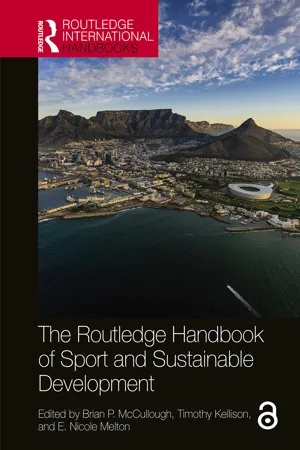
The Routledge Handbook of Sport and Sustainable Development
- 472 pages
- English
- ePUB (mobile friendly)
- Available on iOS & Android
The Routledge Handbook of Sport and Sustainable Development
About This Book
The Routledge Handbook of Sport and Sustainable Development is a comprehensive and powerful survey of the ways in which sport engages with its social, environmental, and ethical responsibilities.
It considers how sport can use its unique profile and platform to influence the attitudes of sport fans and consumers to promote positive social and environmental action around the world and to contribute to sustainable development, perhaps the most important issue of our time. The book is structured around the 17 UN Sustainable Development Goals, with a section devoted to each goal that contains chapters reviewing key theory and current research, measurement and evaluation issues, and the application of current knowledge in real-world development situations. Drawing on research and expertise from management, sociology, development studies, psychology, and other disciplines, the book examines the role that sport must play in areas such as health and well-being, poverty, education, gender equality, decent work, responsible consumption, and climate action.
Representing a keynote work on the wider social responsibilities of sport as both an industry and sociocultural activity, this is essential reading for any advanced student or researcher working in sport development, sport management, sport sociology, event studies, development studies, or environmental studies, and for any development practitioner or sport management professional looking to understand how to achieve positive social change in and through sport.
The Open Access version of this book, available at http://www.taylorfrancis.com, has been made available under a Creative Commons Attribution-Non Commercial-No Derivatives (CC-BY-NC-ND) 4.0 license.
Frequently asked questions
1 An introduction to sport and sustainable development
1.1 The sustainable development goals and early efforts to integrate sport
Goal 1 | End poverty in all its forms everywhere |
Goal 2 | End hunger, achieve food security, and improved nutrition, and promote sustainable agriculture |
Goal 3 | Ensure healthy lives and promote well-being for all at all ages |
Goal 4 | Ensure inclusive and equitable quality education and promote lifelong learning opportunities for all |
Goal 5 | Achieve gender equality and empower all women and goals |
Goal 6 | Ensure availability and sustainable management of water and sanitation for all |
Goal 7 | Ensure access to affordable, reliable, sustainable, and modern energy for all |
Goal 8 | Promote sustained, inclusive, and sustainable economic growth, full and productive employment, and decent work for all |
Goal 9 | Build resilient infrastructure, promote inclusive and sustainable industrialization, and foster innovation |
Goal 10 | Reduce inequality within and among countries |
Goal 11 | Make cities and human settlements inclusive, safe, resilient, and sustainable |
Goal 12 | Ensure sustainable consumption and production patterns |
Goal 13 | Take urgent action to combat climate change and its impacts |
Goal 14 | Conserve and sustainably used the oceans, seas, and marine resources for sustainable development |
Goal 15 | Protect, restore, and promote sustainable use of terrestrial ecosystems, sustainably manage forests, combat desertification, and halt and reverse land degradation and halt biodiversity loss |
Goal 16 | Promote peaceful and inclusive societies for sustainable development, provide access to justice for all, and build effective, accountable, and inclusive institutions at all levels |
Goal 17 | Strengthen the mean of implementation and revitalize the Global Partnership for Sustainable Development |
Sport is also an important enabler of sustainable development. We recognize the growing contribution of sport to the realization of development and peace in its promotion of tolerance and respect and the contributions it makes to the empowerment of women and of young people, individuals and communities as well as to health, education and social inclusion objectives. (General Assembly, 2015, p. 10)
Table of contents
- Cover
- Half Title
- Title Page
- Copyright Page
- Contents
- List of figures
- List of tables
- List of contributors
- Foreword
- Acknowledgments
- List of abbreviations
- 1 An introduction to sport and sustainable development
- Part I: Sustainable Development Goal 1: no poverty
- Part II: Sustainable Development Goal 2: zero hunger
- Part III: Sustainable Development Goal 3: good health and well-being
- Part IV: Sustainable Development Goal 4: quality education
- Part V: Sustainable Development Goal 5: gender equality
- Part VI: Sustainable Development Goal 6: clean water and sanitation
- Part VII: Sustainable Development Goal 7: affordable and clean energy
- Part VIII: Sustainable Development Goal 8: decent work and economic growth
- Part IX: Sustainable Development Goal 9: industry, innovation, and infrastructure
- Part X: Sustainable Development Goal 10: reduced inequalities
- Part XI: Sustainable Development Goal 11: sustainable cities and communities
- Part XII: Sustainable Development Goal 12: responsible consumption and production
- Part XIII: Sustainable Development Goal 13: climate action
- Part XIV: Sustainable Development Goal 14: life below water
- Part XV: Sustainable Development Goal 15: life on land
- Part XVI: Sustainable Development Goal 16: peace, justice, and strong institutions
- Part XVII: Sustainable Development Goal 17: partnerships for the Goals
- Index